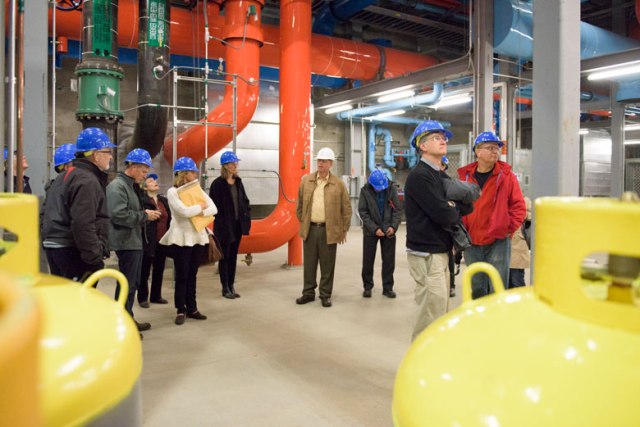Dec 7 2015
When the members of the Faculty Senate arrived in the conference room at Stanford's new Central Energy Facility on Thursday for the last meeting of fall quarter, they found bright blue hard hats awaiting them on the tables.
 Members of the Faculty Senate take a guided tour of the university's new Central Energy Facility on Thursday.
Members of the Faculty Senate take a guided tour of the university's new Central Energy Facility on Thursday.
They put on the hard hats – and earplugs – at the conclusion of the Dec. 3 meeting for a guided tour of the facility, which is the cornerstone of Stanford Energy System Innovations, the university's new cutting-edge energy supply system.
The comprehensive new system incorporates solar power for electricity, combined with heat recovery, to allow the university to exceed the aggressive greenhouse gas emissions reduction goals of California's landmark AB 32 Global Warming Solutions Act, which seeks to reduce greenhouse gas emissions to 1990 levels by 2020. The system eliminates 150,000 tons of carbon dioxide annually, the equivalent of removing 32,000 cars from the road. It will reduce total campus water use by about 15 percent.
Before the guided tour, Bob Reidy, vice president of land, buildings and real estate, said that since the Central Energy Facility opened in April, greenhouse gas emissions have dropped to 137,000 metric tons, compared with the peak level of 228,000 in 2011.
"That's a 40 percent reduction," Reidy said. "When we get a full year of operation in 2016, we'll drop it down to 114,000. That's a 50 percent reduction from the peak."
Reidy said Stanford will continue to see a dramatic reduction in emissions – to 72,000 metric tons in 2017 – when the university turns on the large solar facility it is developing in the desert. He said that represented a 68 percent reduction from 2011 to 2017 – a tremendous accomplishment for a university.
"It only could happen at a place like Stanford," he said.
Joseph Stagner, executive director, sustainability and energy management, and Fahmida Ahmed, director of the Office of Sustainability, also spoke about the new energy system.
The senate postponed a presentation by Harry J. Elam Jr., vice provost for undergraduate education, until winter quarter.
The full minutes of the Dec. 3 senate meeting will be available soon on the Faculty Senate website. The minutes will include the Q&A sessions that followed the presentations.